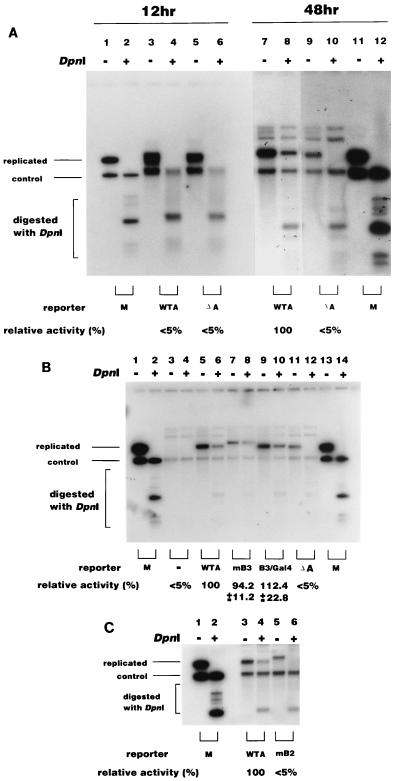FIG. 2.
(A) DpnI assay for ARS plasmids in yeast cells. Plasmids containing wild-type ARS (WTA [pHK801], lanes 3, 4, 7, and 8) or deletions of the A element (ΔA [pKH801−A], lanes 5, 6, 9, and 10) were transfected into yeast cells together with the control plasmid. Twelve or 48 h after transfection, plasmid DNA was recovered, digested with HindIII or HindIII plus DpnI as indicated, and analyzed by Southern hybridization as described in Materials and Methods. The replication activities relative to the WTA plasmid were determined as described in Materials and Methods, and the average results of three independent experiments are indicated under each lane. <5%, replication was under the limit of detection. Mixtures of the WTA plasmid and control plasmids isolated from dam+ and dam3 mutant E. coli were also digested and used as markers (M; lanes 1, 2, 11, and 12). The bands visible above the replicated bands hybridized nonspecifically with the probe. (B) Effect of mutations in the B3 element. The indicated ARS plasmids (pHK801 [WTA], pHK802 [mB3], pHK803 [B3/Gal4], and pHK801-A [ΔA]) were transfected into yeast cells together with the control plasmid, and DNA was analyzed 48 h after transfection as described in Materials and Methods. The positions of DpnI-resistant replicated molecules and the control plasmid are shown. In lanes 3 and 4, no ARS plasmid was transfected. M, marker DNA as described for panel A. The relative replication activities were determined from three independent experiments as described for panel A. (C) Effect of a mutation in the B2 element. The replication activities of wild-type (WTA [pHK801], lanes 3 and 4) and the B2 mutant (mB2 [pHK806], lanes 5 and 6] were measured as described for panel A. The relative replication activities of three independent experiments are indicated under each lane. +, present; −, absent.

